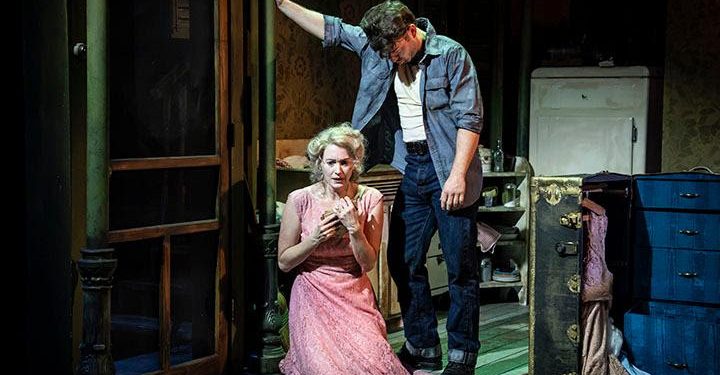By Rikki Lee Travolta
There are great writers throughout history who have a unique voice to their work. In some cases, it’s a composer. In some cases, it’s a novelist. In some cases, it’s a playwright.
Tennessee Williams has a voice all unto himself. It is soaked in alcohol, frustration, passion, shame, pride, and lust. When entrusted to highly skilled performers, his words flow with their own unique cadence.

Paramount Theatre’s “A Streetcar Named Desire” is like whiskey-soaked poetry. There is pleasure in the way it burns with a bitter yet intoxicating flavor.
Directors Jim Corti and Elizabeth Swanson are magnificent in honoring the traditions of the story while brilliantly infusing the sultry piece of entertainment with its own fresh flavor. Think of it as a small batch bourbon – daring, bold, and exquisite to the point of artistic bliss.
The play is a ballet of conflicting emotions, controlled chaos, and distorted harmony. It is a descent into madness told in beautiful dissonant chords.
As with Shakespeare, it requires a specific caliber of actor to embody all the emotions, scars, and desires of a Tennessee Williams character. For a piece as iconic as “A Streetcar Named Desire”, casting plays a big part in achieving success. There are big shoes in history to fill.

The play was first produced on Broadway in 1948, under the direction of Elia Kazan. It starred Jessica Tandy, Kim Hunter, and an unknown Marlon Brando. Tandy won the Tony Award for Best Actress in a Play. The drama also won the Pulitzer Prize.
Stella and Blanche are sisters who come from high society; raised on a plantation known as Belle Reeve. When times grew tough, Stella followed her own drummer and moved to New Orleans where she married a young, blue-collar working man of Polish descent: Stanley Kowalski.
After losing her job and the estate, Blanche shows up on Stella’s doorstep. Outwardly her arrival is for a visit. Later we learn that she is destitute and has nowhere else to go. We also become privy to the fact that she has a drinking problem and is likely suffering from mental illness that dates back to the suicide death of her husband in the youth of their marriage.
Blanche finds the two-room flat where the Kowalski’s live to be seedy and Stanley himself to be common. From the point of her arrival, Blanche and Stanley are like oil and water: two things that just don’t mix.

While staying with her sister and her husband, Blanche strikes a romance with one of Stanley’s friends. Mitch is taken by Blanche’s refined nature, ignoring the fact that she might be older than she leads on. While Stella and Blanche hope the relationship will lead to marriage, Stanley has other ideas.
The role of Stanley was originally written for a middle-aged man with bombastic tendencies. Williams and Kazan, however, felt casting Brando would give the character a youthfulness that might excuse some of his brash outbursts in the eyes of the audience. The role made Brando a star, with the film adaptation earning him his first Academy Award nomination.
As a part of Paramount Theatre’s BOLD Series playing at the Copley Theatre, across the street from the company’s Broadway theater space, “A Streetcar Named Desire” features a trio of dynamic powerhouse performers in its lead roles.
Stella is played by television star Alina Taylor, with her sister Blanche portrayed by Amanda Drinkall and her husband Stanley embodied by Casey Hoekstra. All three are exceptional casting choices, with kudos going to casting director Trent Stork for his overall work on the production.
Also in the cast are Ben Page as Mitch, Joshua L. Green as Steve Hubbel and Andrea Uppling as his wife Eunice, Roberto Antonio Mantica as poker buddy Pablo Gonzales, Adriel Irizarry as a young bill collector, and Desiree Gonzalez as a flower vendor. Irizarry and Gonzalez appear later in the play well disguised in additional roles.

“A Streetcar Named Desire” is easily one of my favorite dramas, and Tennessee Williams is by far my favorite playwright of all time. I have had the pleasure of interpreting his works myself, as well as soaking in the ambiance of many different versions of his work by highly skilled performers.
Prior to the opening of “A Streetcar Named Desire” at the Copley Theatre, I had the opportunity to interview co-director Swanson for the popular entertainment news podcast It’s Showtime with Rikki Lee. Swanson, Corti, and the cast made the decision that at the point Blanche enters the play, she is destitute. She has not a penny to her name and hasn’t had a drink in days, displaying the signs of the DTs reflecting well-developed alcoholism.
I have seen great actresses play the role of Blanche Du Bois. Geraldine Page, Blythe Danner, Jessica Lange, Glenn Close, Natasha Richardson, Cate Blanchette, and Gillian Anderson have all filled the shoes of the aging beauty to great acclaim. However, Amanda Drinkall achieves a level of authenticity that overshadows all who have come before her. Her performance is mesmerizing and nothing short of brilliant. She completely transforms herself into the wild-eyed, sadly broken character.
Lighting designer Cat Wilson and sound designer Forrest Gregor do a wonderful job working in collaboration with the action on stage to show Blanche’s broken psyche. She drifts off from time to time, lost in a sea of distorted reality that is translated to the audience through superb acting combined with audio and visual hints. Adding to this effect is the work of composer and audio associate Kevin O’Donnell.

Taber is best known to audiences as Lexi Olinksky on “Chicago PD” and won the 2023 Heartstrings Award for her supporting performance as Rizzo in Drury Lane’s “Grease.” Over the past year, Taber has shown a dedication to establishing herself as one of the city’s top stage actresses. That hard work is showing clear dividends.
Taber’s Stella has a sense of power not present in many characterizations. For all of Stanley’s loud and brash behavior, Stella maintains a level of control in the relationship. At one point, Stanley is reduced to wordlessly begging for her forgiveness on hands and knees – hinting at the power she controls in the relationship.
One of the things that is so enticing about live theatre is the opportunity to see different actors interpret different roles in their own way. Hoekstra takes a very different approach to Stanley than the young, angry persona originated by Brando.
Hoekstra’s Stanley is a cerebral creature with a proud swagger. Rather than be suspicious of Blanche from the start, he is more inquisitive. It is over time that suspicion and conspiracy start to enter his mind. As his frustrations grow, his volume and temperament rise until they erupt in the play’s brutally graphic climax in which he exercises his dominance over Blanche in the most shocking form possible.

As Stanley’s friend and Blanche’s suitor, Page is a sympathetic figure. There is genuine affection for Blanche. As such, there is definite heartbreak when Mitch learns about elements of her past that affect his ability to continue in the relationship.
The supporting roles are all well played. Irizarry makes a particularly strong showing as a young man collecting for the Kowalski’s newspaper subscription, who gets more than he bargained for from Blanche.
Scenic design by Angeal Weber Miller is spectacular. Miller creates the true feel of a run-down two-room flat in the French Quarter of New Orleans, circa 1940s. The attention to detail is impressive and gives the players the backdrop needed for incredible, heart-wrenching performances.
Costumes are very appropriate for the piece, thanks to the talents of Mara Blumenfeld. Dialect coach Susan Gosdick has clearly done her work as the cast has the accents of the various characters performed to a tee. Properties are done with subtle excellence by Aimee Plant. Intimacy and fight director is Sarah Scanlon; stage manager is Erin Nicole Eggers, assisted by Emma Franklin.

The current mounting of “A Streetcar Named Desire” by Paramount Theatre is a visceral delight. It will make you think. It will make you feel a wide range of emotions as the talented actors and production staff transport you to a world many have never known, a world that wreaks of brutal authenticity. There is both beauty and pain – often at the same time.
“A Streetcar Named Desire” is scheduled through April 21 at Paramount’s Copley Theatre, 8 E. Galena Blvd. in downtown Aurora. For tickets visit www.ParamountAurora.com or call the box office at (630) 896-6666. Paramount’s “A Streetcar Named Desire” demands to be experienced.
Photo credit: Liz Lauren
For more reviews visit: Theatre in Chicago – your source for What’s on Stage in the Chicago Area.





